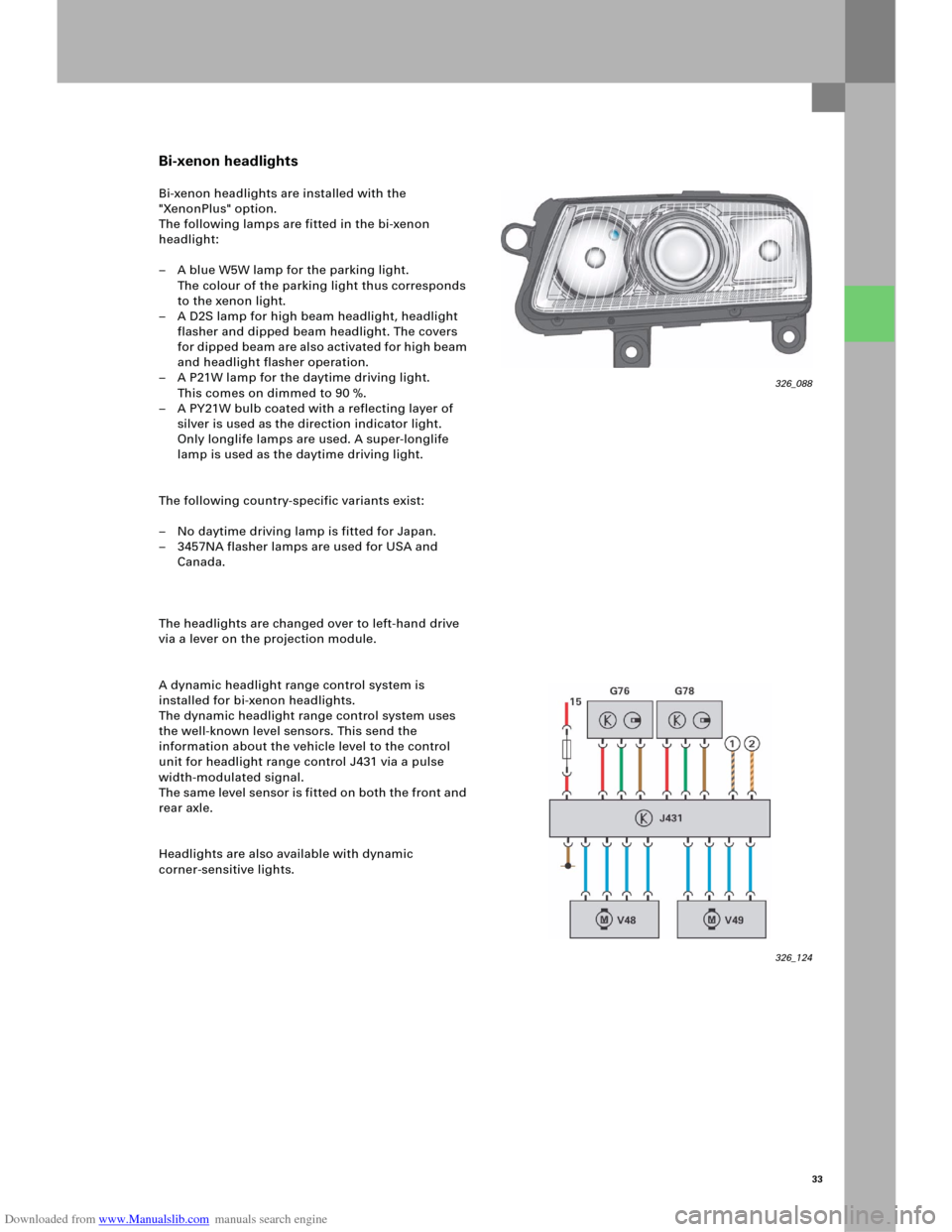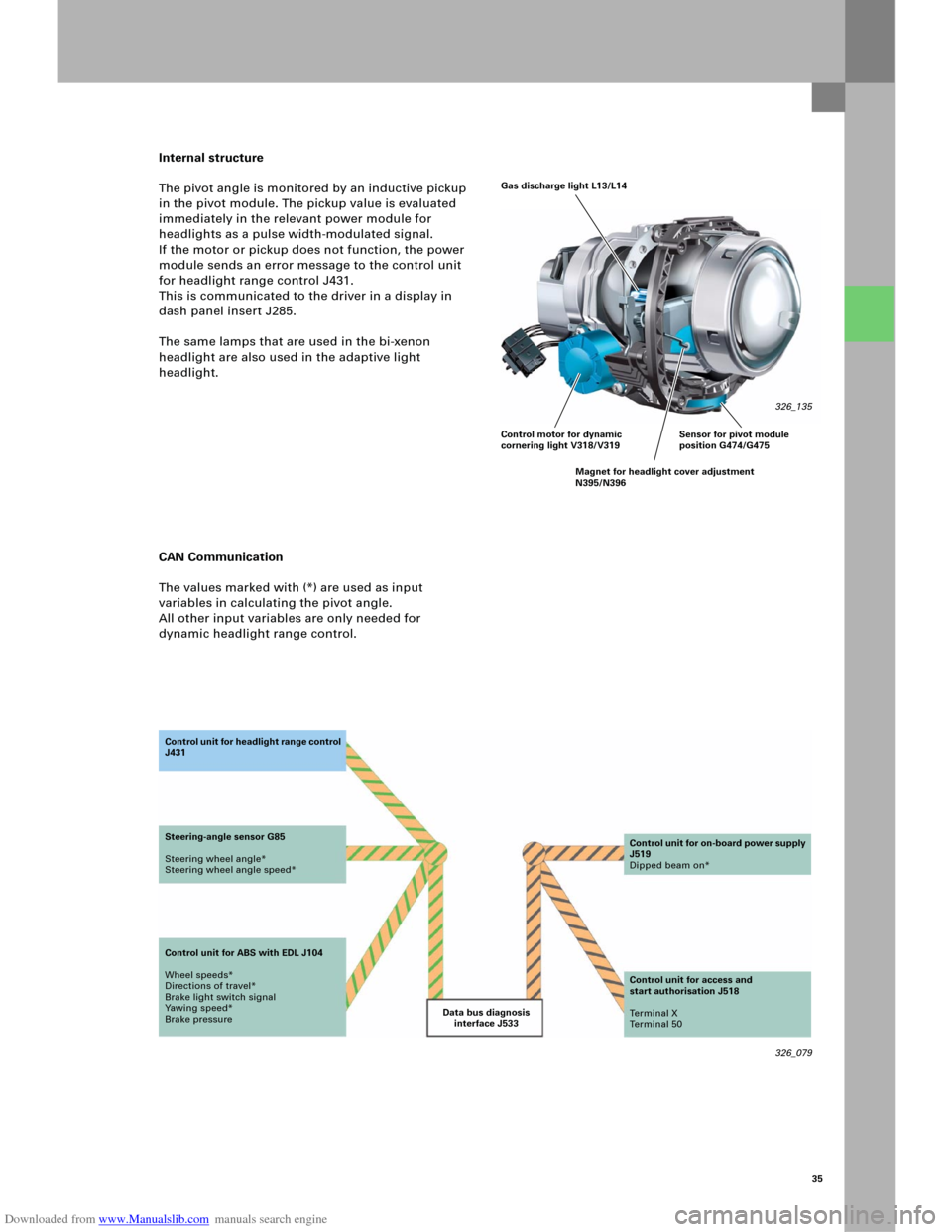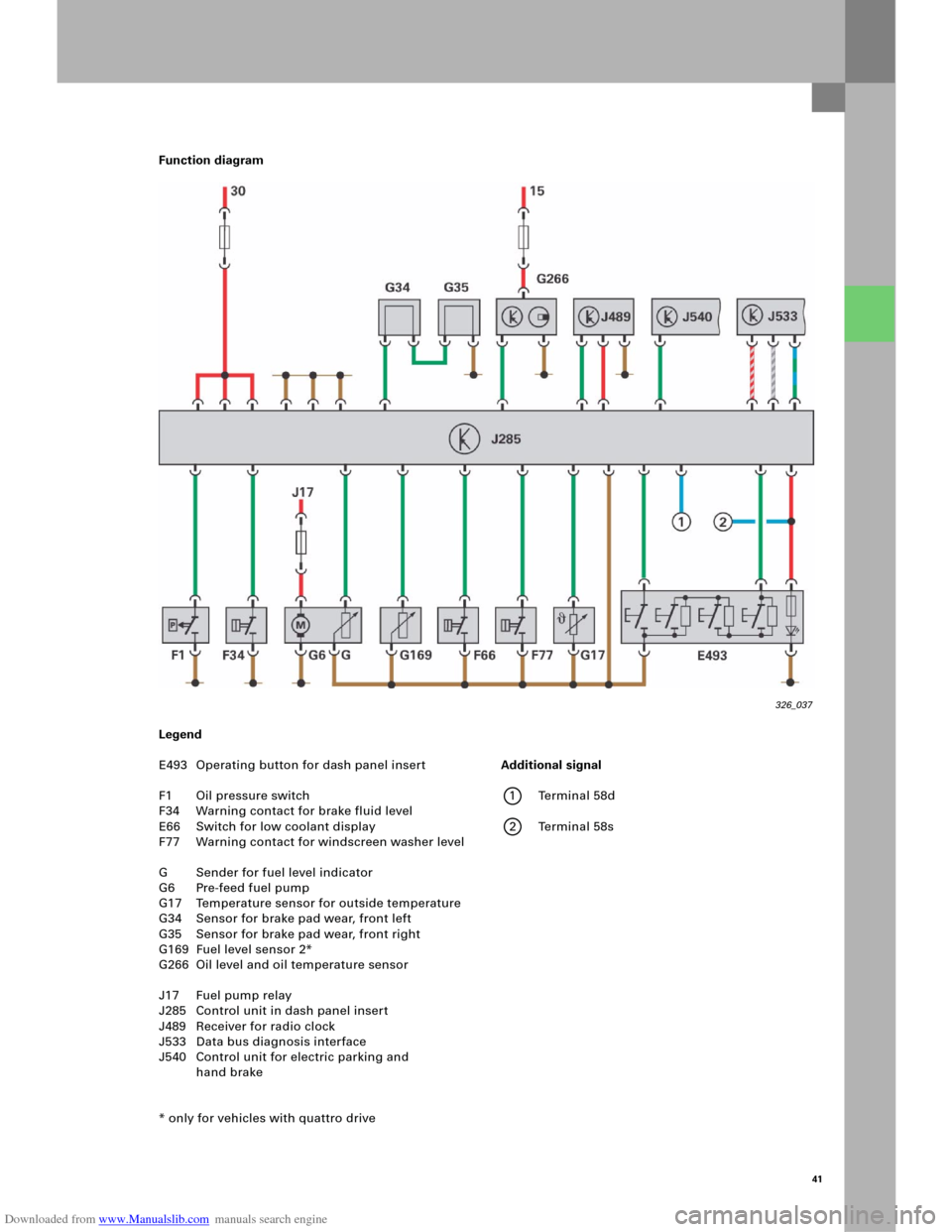AUDI A6 2005 C5 / 2.G Electrics System Training Manual
Manufacturer: AUDI, Model Year: 2005, Model line: A6, Model: AUDI A6 2005 C5 / 2.GPages: 92, PDF Size: 4.42 MB
Page 31 of 92

Downloaded from www.Manualslib.com manuals search engine 33
Bi-xenon headlights
Bi-xenon headlights are installed with the
"XenonPlus" option.
The following lamps are fitted in the bi-xenon
headlight:
– A blue W5W lamp for the parking light.
The colour of the parking light thus corresponds
to the xenon light.
– A D2S lamp for high beam headlight, headlight
flasher and dipped beam headlight. The covers
fo r d i p p ed b e am a re al s o a c t i v at e d fo r h i gh b ea m
and headlight flasher operation.
– A P21W lamp for the daytime driving light.
This comes on dimmed to 90 %.
– A PY21W bulb coated with a reflecting layer of
silver is used as the direction indicator light.
Only longlife lamps are used. A super-longlife
lamp is used as the daytime driving light.
The following country-specific variants exist:
– No daytime driving lamp is fitted for Japan.
– 3457NA flasher lamps are used for USA and
Canada.
The headlights are changed over to left-hand drive
via a lever on the projection module.
A dynamic headlight range control system is
installed for bi-xenon headlights.
The dynamic headlight range control system uses
the well-known level sensors. This send the
information about the vehicle level to the control
unit for headlight range control J431 via a pulse
width-modulated signal.
The same level sensor is fitted on both the front and
rear axle.
Headlights are also available with dynamic
corner-sensitive lights.
326_088
326_124
Page 32 of 92

Downloaded from www.Manualslib.com manuals search engine 34
Adaptive light
The adaptive light works as a dynamic corner-
sensitive headlight. With the dynamic cornering
headlight, the headlight projection module is
pivoted horizontally by an integrated motor.
The headlight lenses and the bracket do not turn.
The pivot angle is approx. 15° on the inner curve
side and 7.5° on the outer curve side.
The various pivot angles have advantages in that
they provide better lighting for corner routes.
In this case, the inner-curve module pivots in twice
as much as the outer-curve module.
This achieves the maximum possible illumination
width with homogeneous light distribution.
No pivoting when vehicle is stationary
The projection modules are not pivoted at driving
speeds of < 6 km/h.
The pivot angle essentially depends on the steering
wheel angle at speeds of more than 10 km/h.
This complies with the legal requirement that the
headlights must not be pivoted when the vehicle is
stationary. At the same time, a slight transition to
headlight pivoting occurs during acceleration from
idle when the steering lock remains constant.
Convenience electrics
326_077
Pivot range
326_076
Page 33 of 92

Downloaded from www.Manualslib.com manuals search engine 35
Internal structure
The pivot angle is monitored by an inductive pickup
in the pivot module. The pickup value is evaluated
immediately in the relevant power module for
headlights as a pulse width-modulated signal.
If the motor or pickup does not function, the power
module sends an error message to the control unit
for headlight range control J431.
This is communicated to the driver in a display in
dash panel insert J285.
The same lamps that are used in the bi-xenon
headlight are also used in the adaptive light
headlight.
CAN Communication
The values marked with (*) are used as input
variables in calculating the pivot angle.
All other input variables are only needed for
dynamic headlight range control.
326_079 Data bus diagnosis
interface J533 Co n t ro l u n it fo r h e a d li g h t ra n g e c o n t ro l
J431
Steering-angle sensor G85
Steering wheel angle*
Steering wheel angle speed*
Control unit for ABS with EDL J104
Wheel speeds*
Directions of travel*
Brake light switch signal
Yawing speed*
Brake pressureControl unit for on-board power supply
J519
Dipped beam on*
Control unit for access and
start authorisation J518
Te r m i n a l X
Te r m i n a l 5 0
Gas discharge light L13/L14
326_135
Control motor for dynamic
cornering light V318/V319
Magnet for headlight cover adjustment
N395/N396Sensor for pivot module
position G474/G475
Page 34 of 92

Downloaded from www.Manualslib.com manuals search engine 36
Signal and data exchange
The same sensors that are used for dynamic
headlight range control for bi-xenon headlights are
also used as level sensors. They send a pulse
width-modulated signal to the control unit for
headlight range control. Data is exchanged between
t h e c o n t ro l u n i t fo r h e ad l i gh t ra n g e c o n tro l J 4 3 1 an d
the power modules in the headlight on the left J667
and right J668 via a 500-kBaud CAN.
Show Room function
The Show Room function can be used to pivot the
headlights by moving the steering wheel – even
when the vehicle is stationary – for presentation.
The function can be adapted using the diagnosis
tester in the control unit for headlight beam
adjustment.
If the vehicle is then driven at more than 30 km/h,
the function is permanently disabled. The function
can be switched on again at any time using the
diagnosis tester.
Convenience electrics
326_074
Audi
Audi A6 2005>
2005 (5)
Saloon
BBJ 3.0l Motronic / 160 kW Guided fault-finding
Function/component selection
Selecting a function or component
Body (Rep. Gr. 01; 50 - 97)
Electrical system (Rep. Gr. 01; 27, 90 - 97)
01 – Self-diagnosis systems
55 – Dynamic headlight range control
J431 – Dynamic headlight range control, Functions
J431 – Contr. unit, head. range control (HRC), General system descr.
J431 – Control unit for headlight range control (HRC), Adaptation
J431 – Contr. unit, head. range control (HRC), Adapt. – Show Room
J431 – Control unit for headlight range control (HRC), Coding
J431 – Control unit for headlight range control (HRC), Replacing
J431 – Control unit for headlight range control (HRC), Basic setting
J431 – Contr. unit, head. range contr. (HRC), Read. meas.-val. blocks
J431 - Contr. unit, head. range control (HRC), selective actuator test
J431 – Contr. unit, head. range contr. (HRC), sequential actuator test
326_085
Page 35 of 92

Downloaded from www.Manualslib.com manuals search engine 37
Back lights
Different tail lights are used in the Audi A6 ’05,
depending on the equipment variant.
This is differentiated into the following:
–Basic variant ECE
–High variant ECE
–High variant SAE
Basic variant ECE
The tail light in the basic variant only uses lamps
with a 15-mm bayonet socket for the lights.
There are three sections for tail light activation.
To ensure that the different-sized sections look from
the outside to be equally illuminated, the central
control unit for the convenience system J393
activates each lamp with a different dimming ratio.
The two inner lamps in each back light are also used
as the brake light.
The outer lamp functions as the "rear fog light".
Ifthe rear fog light is on, only the inner lamp is
active as the brake light.
326_141 Tail light and
rear fog lightTail light and brake light
(if rear fog light is off)
Tail light and
brake light
Direction indicator light Reversing light
Page 36 of 92

Downloaded from www.Manualslib.com manuals search engine 38
High variant ECE
These back lights are installed if bi-xenon headlights
at least are fitted as the front headlights.
The external feature of the High back lights is the
use of LEDs for the brake light.
The LEDs, which are fixed in the reflector housing,
are activated by two contacts from the lamp
bracket.
The rear fog light is located at the bottom of the
back light. Here, the lamp on the driver’s side is
used as the rear fog light, while the lamp on the
passenger’s side serves as the reversing light.
This means that the same lamp bracket can be used
for both the High back light and the Basic back light.
Convenience electrics
326_152 Direction
indicator light
Rear fog light Brake light
Tail lights
Direction
indicator
light
Reversing lightBrake light
Tail lights
Page 37 of 92

Downloaded from www.Manualslib.com manuals search engine 39
High variant SAE
The back lights for the North American market have
standard LED units. The LED units are used for the
indicator and brake light function.
The three sections underneath are for the tail light
lamps.
The S AE back lights have tw o rear fog lights and tw o
reversing lights.
LED unit diagnosis
The failure of an LED is detected by the electronics
in the lamp housing. All LEDs are then switched off
so that the central control unit for the convenience
system J393 can set the relevant fault memory
entry.
326_142 Brake light and
direction indicator lightTail lights
Rear fog light Reversing light
Page 38 of 92

Downloaded from www.Manualslib.com manuals search engine 40
The control unit in dash panel insert J285 is
available in two variants.
The High-Line variant with colour display only
comes in vehicles with adaptive cruise control.
As in the A8 '03, the anti-drive-off feature and
gateway are no longer integrated into the dash
panel insert.
The handy position of the rotary light switch has
meant that the indicator lights for dipped beam
headlight, fog light and rear fog light could also be
fitted directly in the rotary light switch.
Likewise, the buttons for instrument lighting, the
auto-check system and the daily mileage counter
are now positioned to the right, next to the dash
panel insert, in the button module (operating
buttons for dash panel insert E493).
Convenience electrics
Lamp failure
If an exterior lighting lamp fails, a symbol appears
in the central display indicating which lamp has
failed. If you now press the Check button, the failed
lamp is also described by a text message in the
central display.
Outside temperature indicator
The instrument cluster evaluates both the
temperature sensor for outside temperature G17
and the outside temperature signal from the
Climatronic control unit J255. The lower of the two
values is displayed.
Control unit in dash panel insert J285
326_145
Page 39 of 92

Downloaded from www.Manualslib.com manuals search engine 41
Function diagram
Legend
E493 Operating button for dash panel insert
F1 Oil pressure switch
F34 Warning contact for brake fluid level
E66 Switch for low coolant display
F77 Warning contact for windscreen washer level
G Sender for fuel level indicator
G6 Pre-feed fuel pump
G17 Temperature sensor for outside temperature
G34 Sensor for brake pad wear, front left
G35 Sensor for brake pad wear, front right
G169 Fuel level sensor 2*
G266 Oil level and oil temperature sensor
J17 Fuel pump relay
J285 Control unit in dash panel insert
J489 Receiver for radio clock
J533 Data bus diagnosis interface
J540 Control unit for electric parking and
hand brake
* only for vehicles with quattro drive
326_037
Additional signal
1 Terminal 58d
2 Terminal 58s
Page 40 of 92

Downloaded from www.Manualslib.com manuals search engine 42
Functions
The main function of the control unit for on-board
power supply is to read in switch information and
activate power outputs.
It is familiar from the Audi A8 ‘03 and has been
adapted to new functionalities in the Audi A6 ´05.
Master functions
The following master functions are implemented in
the control unit for on-board power supply.
– External lighting control
– LIN master for the control unit for
wiper motor J400
– LIN master for the sensor for rain and
light detection G397 (for details of function,
see Sensor for rain and light detection)
Stand-by master function
If the central control unit for the convenience
system J393 fails, the control unit for on-board
power supply J519 takes over the stand-by master
function. It sends the information for direction
indicators to the CAN bus.
Convenience electrics
326_107
Reference
Further information on this can be found in the
SSP 288, Audi A8 ’03 – Distributed Functions.
326_108
Control unit for on-board power supply J519
J519
G397 J400